Baumgarte T., Shapiro S. Numerical Relativity. Solving Einstein’s Equations on the Computer
Подождите немного. Документ загружается.

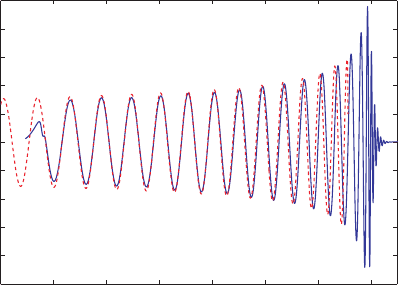
13.2 Binary black hole inspiral and coalescence 441
−1400 −1200 −1000 −800 −600 −400 −200 0
−0.2
−0.15
−0.1
−0.05
0
0.05
0.1
0.15
0.2
0.25
time (M)
rh (M)
Figure 13.7 Comparison of the gravitational waveform h(t) from an equal-mass, nonspinning black hole binary
as obtained in the numerical simulations of Baker et al. (2007a) (solid line) with the corresponding
post-Newtonian result to order 2.5PN in the amplitude and order 3.5PN in the phasing (dashed line; see Blanchet
2006). Here r is the distance to the source. The gravitational wave strain h is based on the dominant l = 2, m = 2
spin-weighted spherical harmonics of the radiation and represents an observation made in the system’s equatorial
plane, where only the h
+
polarization contributes to the strain. [From Baker et al. (2007a).]
Figure 13.6 demonstrates mass-energy conservation in the calculations of Baker et al.
(2006a). This calculation used AMR, with a grid resolution of x = M/32 on the finest
grid, and with the outer boundary at 128M. The comparison is performed for gravitational
wave extraction at both 40M and 50M. Except for some fluctuations at early times, caused
by a transient pulse in the gauge evolution that affects the measurement of the ADM
mass, the agreement is remarkably good, and provides one measure of the accuracy of the
simulation.
In a follow-up study, Baker et al. (2007a) compared their gravitational waveforms
with those obtained from post-Newtonian approximations.
25
For such a comparison it is
important to start the inspiral from a large binary separation, where one would expect the
two approaches to agree well. Baker et al. (2007a) therefore use as initial data a binary with
an orbital angular frequency of approximately M = 0.0255, which may be compared
with the values at the ISCO listed in Table 12.2. This binary completes about seven
orbits, and hence about 14 gravitational wave cycles, before coalescence. The agreement
with post-Newtonian predictions well into the merger phase is remarkable. Figure 13.7
compares the gravitational waveform generated by the numerical simulations with the the
post-Newtonian prediction to order 2.5PN in the amplitude and to order 3.5PN in the phase.
The numerical simulation uses fourth-order finite differencing, AMR, and a resolution of
25
See Appendix E as well as Blanchet (2006).
442 Chapter 13 Binary black hole evolution
approximately M/32 on the finest grid. While the agreement is not perfect, it is consistent
with the internal error estimates in either one of the two approaches.
26
Given the different algorithms and implementations used in the simulation of binary
black holes, it is of interest to compare how well predictions from these different codes
agree. This has been addressed by Baker et al. (2007b), who provide a comparison of the
results obtained with the codes of Pretorius (2005a), Campanelli et al. (2006)andBaker
et al. (2006a). If the only differences between these simulations originate in the adopted
formulation of Einstein’s equations, gauge conditions and specifics of the numerical imple-
mentation, then clearly all of them should yield the same results for physical invariants
in the limit of infinite resolution. However, the simulations differ in other aspects, too.
One difference lies in the initial data. For the calculations presented in Buonanno et al.
(2007), Pretorius adopts the corotational, conformal thin-sandwich binary black hole data
of Cook and Pfeiffer (2004). The other two groups, on the other hand, adopt nonspinning
puncture initial data. Even though the simulations start with quasiequilibrium initial data
describing a binary at quite similar proper separations and angular velocities, they carry
different total angular momenta.
27
Moreover, the different groups use different algorithms
for the extraction of gravitational waves (see Chapter 9.4). Despite these differences, it is
remarkable how well the predictions for the asymptotic gravitational wave signals agree, as
showninFigure13.8. The agreement is particularly convincing for the waveforms emitted
during the merger phase. At earlier times, shown in the inset, especially when the signal is
dominated by noise associated with the initial data, the agreement is worse, as one would
expect.
Figures 13.7 and 13.8 also demonstrate how “simple”, in some sense, the gravitational
wave signal from the merger of a binary black hole system appears. One can easily
identify the familiar “chirp” signal, emitted during the late inspiral phase, during which
both the wave amplitude and frequency increase. The signal terminates, as expected, with
quasinormal ringing, as the merger remnant settles down to stationary equilibrium. The
transition from the chirp to the ringdown part of the signal is rather smooth, and not at
all abrupt. This feature is related to the relatively smooth transition of the binary orbit
from inspiral to merger, as described in Chapter 12. While we have defined and located
the ISCO as the last stable circular orbit for the quasiequilibrium models considered in
Chapter 12, the ISCO does not mark a very sudden transition, but rather a gradual change
from inspiral to plunge. This can be seen in Figure 13.4, which displays no sharp plunge
prior to merger.
In fact, the inspiral is approximated remarkably well by the Newtonian quadrupole
expressions of Exercise 12.3 until late times.
28
A dynamical instability in the binary orbit
26
A similar analysis, based on the numerical simulations of Pretorius (2005a), has been presented in Buonanno et al.
(2007).
27
Even for identical angular momenta, the quasiequilibrium data constructed from the conformal thin-sandwich approach
and the puncture data may not represent slices of identical spacetimes; see the discussion in Chapter 12.
28
See Buonanno et al. (2007) for a detailed analysis.
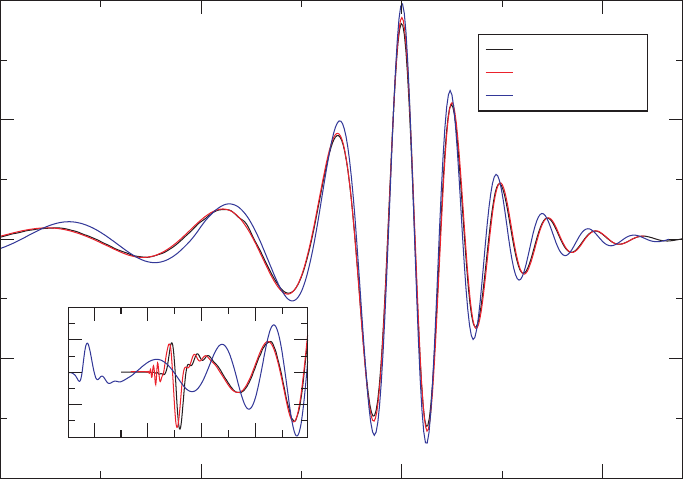
13.2 Binary black hole inspiral and coalescence 443
−100
−50
0
50
t/M
f
−0.04
−0.02
0
0.02
0.04
r ψ
4
M
f
GSFC (R1)
UTB (s00)
Pretorius (d16)
−250
−200
−150
−100
−0.004
−0.002
0
0.002
0.004
Figure 13.8 Comparison of the gravitational waveforms Re(ψ
4
) obtained by three independent research groups:
Pretorius (Pretorius 2005a; Buonanno et al. 2007), Goddard Space Flight Center (GSFC, e.g., Baker et al.
(2006a) and University of Texas at Brownsville (UTB, e.g., Campanelli et al. 2006). [From Baker et al. (2007b).]
at the ISCO should be reflected in a departure of the waveform from this expression.
However, a common horizon forms sufficiently early to absorb much of the radiation
generated during such an epoch and mask any such departure.
Simulations that can track binary black hole inspiral from large separation allow us to
estimate the total energy emitted in gravitational radiation during the entire coalescence
event. Baker et al. (2007b) find that approximately 3.5% of the total initial mass-energy
M is radiated away during the late inspiral and merger, starting from a proper horizon
separation of about 10M; other investigations are in reasonable agreement. The amount
of energy radiated during the early inspiral from infinite separation to the separation of
10M can be estimated from the binding energy of the initial data at 10M. Using the
values reported in Caudill et al. (2006)andBuonanno et al. (2007), the radiated energy
is about 1.2% of M.
29
The total amount of energy radiated during inspiral from infinite
separation is therefore between about 4.5 and 5% of the total initial mass-energy. This value
is significantly less than the maximum possible value of 29% allowed by the area theorem
29
See Tables 12.1 and 12.2, where we list the binding energies at the ISCO, i.e., at slightly smaller binary separation.
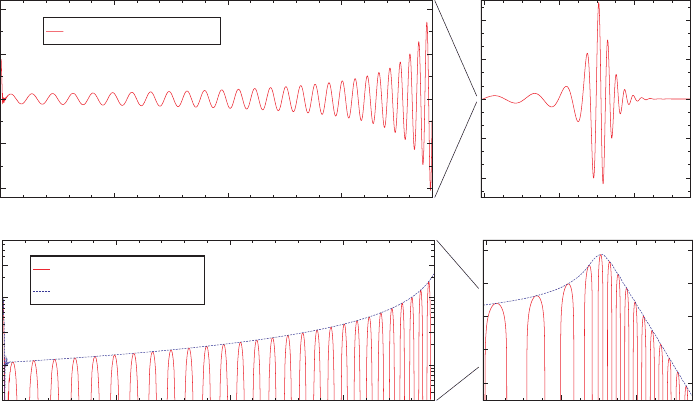
444 Chapter 13 Binary black hole evolution
0 1000 2000 3000
−0.002
−0.001
0
0.001
0.002
Re(r M Ψ
4
) l=2, m=2
3800 3900 4000
−0.06
−0.03
0
0.03
0.06
(t
S
− r
*
)/M(t
S
− r
*
)/M
(t
S
− r
*
)/M
0 1000 2000 3000
0.0001
0.0003
0.001
0.003
Re(r M Ψ
4
) l=2, m=2
| r M Ψ
4
| l=2, m=2
3800 3900 4000
10
−5
10
−4
10
−3
10
−2
10
−1
(t
S
− r
*
)/M
Figure 13.9 The gravitational waveform, extrapolated to spatial infinity, for an equal-mass, nonspinning, black
hole binary. The top panel shows the real part of the dominant l = 2, m = 2 mode of ψ
4
on the linear scale, the
bottom panel on a logarithmic scale. The panels on the right show an enlargement of the data for the merger and
ringdown. [From Scheel et al. (2009).]
(see exercise 7.2), but considerably more than the energy radiated during a head-collision
fromrestatinfinity( 1%; see Chapter 10.2.)
Building on these initial successes, many other investigators followed up with their own
simulations of the inspiral and merger of equal-mass binary black holes. As an example
we show results from a highly refined simulation, based on a carefully groomed, pseudo-
spectral implementation of a first-order version of the generalized harmonic formalism, in
Figure 13.9.
30
In Appendix I we present results in greater detail for two simulations of the inspiral and
merger of nonspinning binary black holes. One simulation describes an equal-mass binary
and the other describes a binary with a mass ratio of 3:1 (see the following section). These
particular simulations employ a finite difference implementation of the moving puncture
method within the BSSN formalism and employ puncture initial data. In the Appendix
we tabulate specific information about the adopted AMR grid set-up, the finite difference
implementation, the initial data, and the diagnostics, as well as the emitted gravitational
radiation and the black hole recoil. We also plot the orbital trajectories of the black
holes and the emitted gravitational waveforms. The purpose of this Appendix is twofold:
First, from a practical computational perspective, these two simulations provide handy
30
See Scheel et al. (2009), as well as Lindblom et al. (2006), for a first-order version of the generalized harmonic
formalism.
13.2 Binary black hole inspiral and coalescence 445
test-bed calculations for researchers seeking to perform similar simulations with their
own algorithms and vacuum codes. Second, from a pedagogical perspective, the summary
provided in the Appendix pinpoints where in the course of performing and evaluating a
binary black hole simulation one is required to implement many of the basic concepts and
tools that have been developed in this book. References to the places in the book where
these concepts and tools are introduced are provided throughout Appendix I.
13.2.2 Asymmetric binaries, spin and black hole recoil
In the last section we focused on equal-mass, nonspinning binaries. While this is a very
natural case to study first, it clearly is not a generic scenario: binary black holes in nature
are likely to have unequal masses and nonzero spins. It therefore is of great interest to
understand how the findings of the previous section change for mass ratios different from
unity and how they are affected by black hole spin.
Allowing for unequal masses and black hole spin will certainly alter the gravitational
signal emitted during the inspiral and merger. It is therefore crucial to understand these
effects for the detection of gravitational waves from binaries. In fact, the accurate extraction
of binary parameters from an observed gravitational wave signal requires a large catalog
of templates of theoretical waveforms compiled for binaries with different mass ratios and
spin parameters.
However, the detection and interpretation of gravitational wave signals is not the only
astrophysical motivation for the study of asymmetric binaries. As it turns out, one important
consequence – black hole recoil – is suppressed in the symmetric binary scenarios of
Section 13.2.1, but plays an important role in several different astrophysical contexts, as
we will sketch below.
Black hole recoil can be understood qualitatively as follows. Gravitational radiation gen-
erally carries both energy and momentum. In symmetric binaries, the total linear momen-
tum radiated by the binary must be zero: the contributions to the radiated linear momentum
from the two black holes cancel. This cancelation does not occur in an asymmetric binary,
which therefore radiates a nonzero net linear momentum. Given this linear momentum loss,
the center of mass of the system acquires a linear momentum in the opposite direction.
In a frame in which the binary’s center of mass was originally at rest prior to merger, the
remnant will thus end up with a nonzero “kick” velocity.
Just how large this recoil or kick velocity V
kick
is has important astrophysical and
cosmological implications. For example, supermassive black holes with masses in the
range 10
6
M
− 10
9
M
are believed to reside at the centers of many, if not most, bulge
galaxies, including the Milky Way. One plausible scenario for their formation is through a
combination of mergers with other black holes and gas accretion. The mass and age of the
initial “seed” black hole is unknown, but it could be in the range 60−600M
if it is the
collapsed remnant of a first-generation Population III star,
31
or much higher than 10
3
M
31
Madau and Rees (2001).
446 Chapter 13 Binary black hole evolution
if it is the remant of a collapsed supermassive star.
32
Binary black holes can form during
the merger of their host galaxies. This process is believed to be take place in the context of
the cold dark matter (CDM) model of structure formation in the early Universe, where
dark matter halos merge hierachically and black holes are assumed to settle, merge and
accrete in their gaseous centers.
Clearly, for the remnant of such mergers to remain within any host, the kick speed V
kick
has to be less than the escape velocity of that host. In giant elliptical galaxies and spiral
galaxies, the central escape velocities V
esc
are roughly between 500 km/s and 2000 km/s.
33
If kick speeds routinely exceeded these escape speeds, this would clearly call into question
whether supermassive black holes can form via hierarchical merger,
34
and might favor
instead growth via pure accretion, or some other mechanism. On the other hand, even a
modest kick speed V
kick
would be sufficient to explain the apparent absence of massive
black holes in dwarf galaxies and globular clusters, for which the central escape speed is
significantly smaller than for giant galaxies.
35
A typical kick speed just below the escape speed should result in a finite probability of
finding remnant supermassive black holes displaced from the center of their host galaxies.
Eventually, dynamical friction (gravitational scattering off other stars) will cause the orbit
of the black hole to decay back to the galaxy center, as it transfers kinetic energy to the
other stars in the galactic nucleus.
The ejection of merger remnants from globular clusters reduces the likelihood of further
mergers and thus decreases the probability of observing binary black hole mergers in such
clusters. For the same reason, black hole merger remnants have difficulty remaining in
high redshift halos with relatively shallow potential wells.
Another important consequence of black hole mergers is its effect on the spin evolution
of a supermassive black hole. The growth rate of a black hole by gas accretion is a function
of its efficiency of conversion of accreted rest-mass into electromagnetic radiation, and
this efficiency depends sensitively on the spin parameter a/M of the black hole. Black
holes with smaller spin parameters have lower efficiency and thus grow more quickly for
a given luminosity. It is thus a crucial question whether or not the combination of mergers
and gas accretion at the Eddington limiting luminosity
36
is sufficiently rapid to build a
supermassive black hole to power QSO SDSS 1148 + 5251, the quasar with the highest
known redshift (z = 6.4) at the time of the writing of this book. This quasar is believed to
host a 10
9
M
black hole, which therefore implies that a seed black hole must be able to
grow to this size within 0.9 Gyr after the Big Bang in the standard CDM cosmology. The
32
See Rees (1984)andShapiro (2004b) for discussions of supermassive star collapse and alternative scenarios for
forming supermassive black hole seeds. See Chapter 14.2 for simulations of massive star collapse to black holes.
33
See, e.g., Figure 2 of Merritt et al. (2004) for the central escape speeds of various types of galaxies and star clusters.
34
We note that the kick speed is independent of the total mass of the binary, a result that is consistent with the fact that,
when expressed in gravitational units, speed is dimensionless.
35
See Volonteri (2007) and references therein for calculations of the effect of recoil on the formation of supermassive
black holes.
36
The Eddington limit L
Edd
is the critical luminosity at which the outward force of radiation pressure equals the inward
pull of gravity in an accreting plasma. See, e.g., Shapiro and Teukolsky (1983), Section 13.7 for a derivation.
13.2 Binary black hole inspiral and coalescence 447
existence of this black hole may constrain the spin evolution of its accreting progenitors
and the viability of the merger-accretion scenario for supermassive black hole growth.
37
We note that each time binary black holes of comparable mass merge (a “major merger”),
the remnant acquires an appreciable spin, arising largely from the orbital angular momen-
tum of the binary near the ISCO. For example, the merger of two equal-mass, nonspinning
black holes results in a remnant with spin parameter a/M ≈ 0.7(seeTableI.4). By con-
trast, the merger of a massive black hole with multiple small-mass companions (“minor
mergers”) that inspiral in isotropically-oriented orbits will spin down the massive black
hole as it grows.
38
Gaseous disk accretion will drive up the spin of the black hole; spin
equilibrium will be achieved for a value of a/M that depends on precise details of the
accretion process. For example, ignoring radiation loss, accretion from a standard relativis-
tic “thin disk” will drive the spin up to its maximal value, a/M = 1,
39
while accounting for
photon emission shifts the equilibrium value back down to a/M = 0.998.
40
Simulations
of relativistic MHD accretion onto Kerr black holes, however, suggest that the disk may
not be so thin and the equilibrium spin value may be significantly lower, a/m ∼ 0.9.
41
The spin of a supermassive black hole at any one time may thus be determined by the
mechanism that has dominated its most recent growth.
42
Finally, as we will see below, the merger of spinning black holes of comparable mass
may cause the spin axis of the remnant to flip. It has been speculated that this phenomenon
could explain the observation of X-shaped radio jets, in which the orientation of the emitted
jets seems to have changed abruptly in the past.
Unequal masses
Historically, black hole recoil was first considered for unequal-mass binaries with non-
spinning companions. In such a binary the less massive star or black hole resides at a
larger separation from the center of mass than the more massive companion, and hence
orbits with a larger orbital speed. The two objects therefore emit gravitational radiation
at different rates, and, in a crude analogy to electromagnetism, the radiation from the
faster object is more highly “beamed” in the forward direction than the radiation from the
slower object. As a consequence the linear momentum emitted from the two companions
no longer cancel, hence the center of mass acquires some linear momentum in the process.
In the absence of spin, the situation is symmetric across the orbital plane, which implies
that the radiation reaction force must lie in this plane. Over the course of one orbit the
direction of the force also completes a full circle – similar to a spinning lawn sprinkler that
37
See Shapiro (2005)andVolonteri and Rees (2006) for discussion and references.
38
a/M ∼ M
−7/3
; Hughes and Blandford (2003); Gammie et al. (2004). Spindown occurs because the orbital angular
momenta of counter-rotating companions at their ISCOs are larger in magnitude than those of corotating companions.
39
Bardeen (1970).
40
Thorne (1974).
41
De Villiers et al. (2003); Gammie et al. (2004).
42
See Berti and Volonteri (2008) and references therein for studies of cosmological black hole spin evolution by mergers
and accretion, with observational implications.

448 Chapter 13 Binary black hole evolution
ejects water in a rotating beam. If the orbit were strictly circular, the motion of the center of
mass would therefore also describe a circle, making the net effect vanish. Instead, however,
the binary orbit inspirals slowly, so that the binary emits slightly more linear momentum
at the end of one orbit than at the beginning. As a consequence, the center of motion does
not follow a perfect circle, but instead describes an outward spiral – which can be pictured
by imagining a spinning lawn sprinkler that emits water at an increasing rate. The process
ends when the binary merges and ceases to emit linear momentum. At that point the center
of mass will follow a rectilinear trajectory, having acquired a kick speed V
kick
in a random
direction in the orbital plane.
The first quantitative analysis of this process was performed by Fitchett (1983), who
evaluated the lowest-order multipole moments for a Newtonian point-mass binary to obtain
the emitted linear momentum. He finds that the kick speed is approximately
43
V
kick
≈ 1480 km/s
f (q)
f
max
2M
r
term
4
(13.5)
where q = m
1
/m
2
≤ 1 is the mass ratio, M = m
1
+ m
2
is the total mass, and r
term
is the
binary separation at which the linear momentum emission terminates.
44
The function f (q)
is given by
f (q) = q
2
1 − q
(1 + q)
5
(13.6)
and assumes a maximum of f
max
0.0179 at q = (3 −
√
5)/2 0.38. The kick speed
vanishes both for equal-mass binaries (q = 1) and in the test-particle limit, q = 0, as one
would expect. Assuming that r
term
may come close to the gravitational radius 2M,the
above expression predicts large kick speeds that easily exceed 1000 km/s. However, later
analytical estimates, based on perturbation theory or post-Newtonian calculations, revised
the maximum kick speed to smaller values of at most a few hundred km/s.
45
With the availability of numerical codes that can simulate the inspiral and coalescence of
binary black holes, it is possible to compute the recoil kick speed without approximation.
The first such attempt was carried out by Herrmann et al. (2007a),whousedverycrude
initial data. The first accurate calculation was presented by Baker et al. (2006b), who found
a kick speed of 105 ± 10 km/s for a mass ratio of q = 0.67.
46
A more comprehensive and very accurate study has been carried out by Gonz
´
alez
et al. (2007). The computational methods used in these simulations are similar to those
of Campanelli et al. (2006)andBaker et al. (2006a) described above; in particular they
use the moving puncture method to model the black holes (see Section 13.1.3), the BSSN
43
Favata et al. (2004).
44
cf. exercise 13.3 below.
45
See, e.g., Kidder (1995); Favata et al. (2004); Blanchet et al. (2005); Damour and Gopakumar (2006); Sopuerta et al.
(2007).
46
While Baker et al. (2006b) was published in a journal before Herrmann et al. (2007a), the latter appeared on the
xxx.arXiv.org preprint server approximately two month before the former.
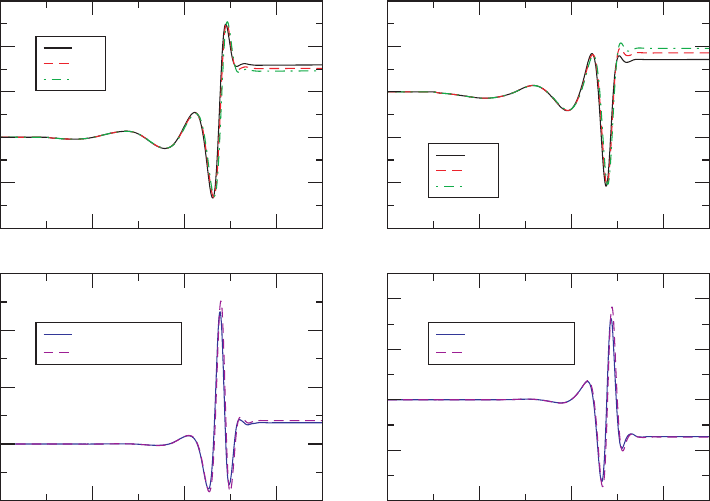
13.2 Binary black hole inspiral and coalescence 449
300
200
h1
h2
h3
h1
h2
h3
200
100
v
x
(km/s)
∆v
x
(km/s)
∆v
y
(km/s)
v
y
(km/s)
100
100
−100
100
100
200
200
t(M
ADM
)
t(M
ADM
)
t(M
ADM
)
t(M
ADM
)
300
300
−200
−200
−300
0
0
0
60
40
40
20
(h1-h2) (h1-h2)
1.45858*(h2-h3) 1.45858*(h2-h3)
20
0
0
0
100 200 300
0
−20
−20
−40
100 200 300
0
Figure 13.10 Components of the kick velocity as a function of time in the simulations of Gonz
´
alez et al. (2007)
for a nonspinning binary of mass ratio q = 0.33. The graphs show results for three different resolutions, the
finest of which are h
1
= m
1
/45, h
2
= m
1
/51, and h
3
= m
1
/58, where m
1
is the smaller black hole’s irreducible
mass. The convergence test in the lower panels demonstrates second-order convergence. As expected, the kick
velocity oscillates during the inspiral, and then remains constant once the emission of linear momentum ceases.
[From Gonz
´
alez et al. (2007).]
formulation of Einstein’s equations (Chapter 11.5), and an AMR grid structure.
47
Gonz
´
alez
et al. (2007) construct puncture initial data (see Chapter 12.2) describing unequal mass
binaries, fixing binary parameters as obtained in post-Newtonian calculations. These initial
data contain some small amount of spurious gravitational radiation, which propagates
off the numerical grid via an initial pulse. Once this pulse has passed, integration of
equation (9.132), yields the kick momentum P
i
. In the calculations of Gonz
´
alez et al.
(2007), the Weyl scalar ψ
4
is extracted at r
ext
= 50M.
In Figure 13.10 we show the x and y components of the kick velocity V
kick
for a binary
of mass ratio q = 0.33, calculated from the components of the momentum P
i
by dividing
by the final remnant black hole mass. The z component vanishes identically, since it would
describe motion perpendicular to the orbital plane. As we would expect from our discussion
47
Details of this numerical integration, together with many code tests and benchmarks, can be found in Br
¨
ugmann et al.
(2008).
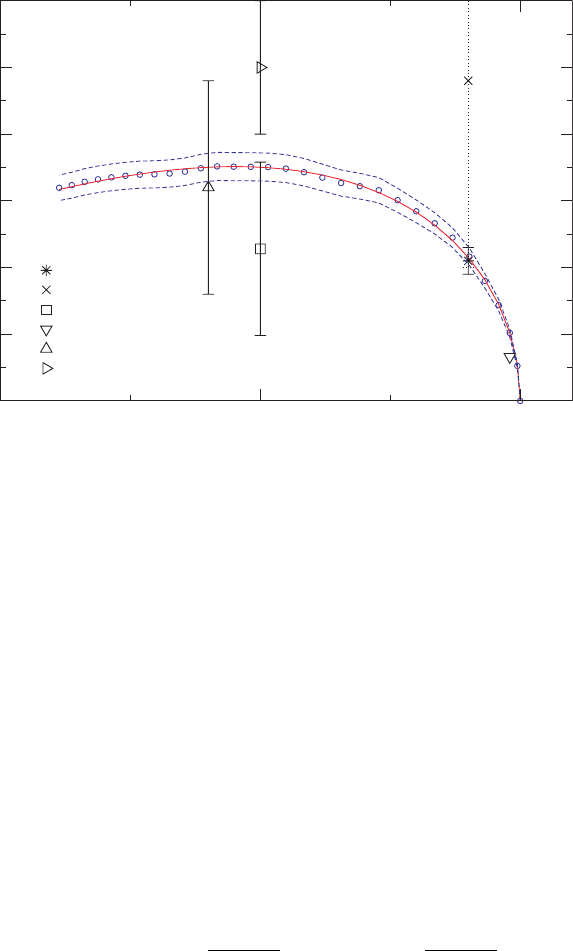
450 Chapter 13 Binary black hole evolution
0.15
0.2
0.25
η
0
50
100
150
200
250
300
v (km/s)
Baker, et al
Campanelli
Damour and Gopakumar
Herrmann, et al
Sopuerta, et al
Blanchet, et al
Figure 13.11 The kick velocity as a function of the symmetric mass-ratio parameter η = q/(1 +q)
2
,whereq is
the ratio of irreducible masses. The line connecting the open circles, together with the dashed line marking a 6%
error, denote the results of Gonz
´
alez et al. (2007). Also plotted are the earlier numerical results of Baker et al.
(2006b), Campanelli (2005), Herrmann et al. (2007a), as well as the analytical results of Blanchet et al. (2005);
Damour and Gopakumar (2006); Sopuerta et al. (2007). [From Gonz
´
alez et al. (2007).]
above, the kick velocity initially oscillates with an increasing amplitude, until the remnant
experiences a final kick during the black hole merger. Shortly after that the emission of
linear momentum ceases, leaving the remnant to coast with a net kick speed V
kick
in a
random direction in the orbital plane.
Figure 13.11 shows the final kick speed V
kick
for a number of different mass ratios.
The maximum value of V
kick
= 175 ± 11 km/s is obtained for an irreducible mass ratio
of q = 0.36 ± 0.03.
48
Quite remarkably, this mass ratio is consistent with that of the
maximum value of Fitchett’s expression (13.5). In an extension of the work of Buonanno
et al. (2007), Berti et al. (2007) synthesized numerical calculations of the inspiral, merger
and ringdown of unequal mass binaries. In particular, they find that the total energy E
GW
emitted during the merger phase is approximately
E
GW
/M = 0.032661
&
4q
(1 + q)
2
'
2
+ 0.004458
&
4q
(1 + q)
2
'
4
(13.7)
where M is the total initial ADM mass of the binary. Note that for equal-mass binaries with
q = 1 we recover a value close to the 3.5% that we stated in Section 13.2.1. Berti et al.
(2007) also find that the angular momentum of the remnant black hole is well approximated
48
See also the simulation for q = 1/3 described in detail in Appendix I.
